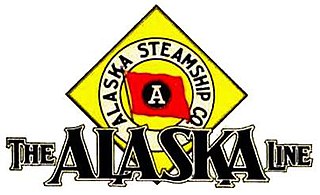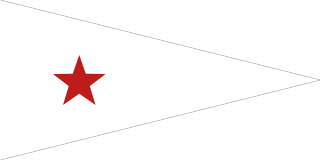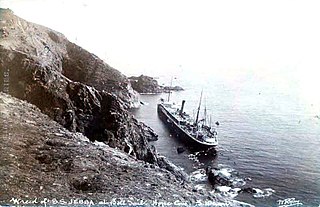
SS Yongala was a passenger steamship that was built in England in 1903 for the Adelaide Steamship Company. She sank in a cyclone off the coast of Queensland in 1911, with the loss of all 122 passengers and crew aboard.

The term Mosquito Fleet has had a variety of naval and commercial uses around the world.

The North Coast railway line is a 1,681-kilometre (1,045 mi) 1067 mm gauge railway line in Queensland, Australia. It commences at Roma Street station, Brisbane, and largely parallels the Queensland coast to Cairns in Far North Queensland. The line is electrified between Brisbane and Rockhampton. Along the way, the 1680 km railway passes through the numerous towns and cities of eastern Queensland including Nambour, Bundaberg, Gladstone, Rockhampton, Mackay and Townsville. The line though the centre of Rockhampton runs down the middle of Denison Street.

The Illawarra Steam Navigation Company was a shipping company that serviced the south coast of New South Wales, Australia from 1858 to the early 1950s. It was formed through the amalgamation of the General Steam Navigation Company, the Kiama Steam Navigation Company and the Shoalhaven Steam Navigation Company, each of whom serviced parts of the south coast with their respective vessels. After merging, the new company held a near monopoly in regard to shipping on the south coast, and their fleet visited every significant port between Sydney and the border of Victoria. The company transported both passengers and a range of produce, including livestock, and hence it became known as the 'Pig and Whistle Line': it was said that ships would wait an hour for a pig but not a minute for a passenger.

The Alaska Steamship Company was formed on August 3, 1894. While it originally set out to ship passengers and fishing products, the Alaska Steamship Company began shipping mining equipment, dog sleds, and cattle at the outbreak of the Klondike Gold Rush of 1897. The company was purchased by the Alaska Syndicate and merged with the Northwestern Steamship Company in 1909, but retained its name, and the fleet was expanded to 18 ships. During World War II, the government took over the company's ships. When the war ended, the company struggled to compete with the new Alaska Highway for passengers and freight. It discontinued passenger service altogether in 1954 and shut down operations in 1971.

The Johnstone River, comprising the North Johnstone River and the South Johnstone River, is a river system in Far North and North Queensland, Australia.

HMAS Carroo was a lighter of the Royal Australian Navy (RAN) between 1942 and 1946 during World War II. Built for G. S. Yuill, London, she was sold to the Adelaide Steamship Company in September 1897. She was requisitioned by the RAN in June 1942 until she was returned to her owners in 1946. She was sold in 1954 to Hopewell Steam Shipping Company Ltd, Maryborough and was renamed Kgari. She was scuttled at Roy Rufus Reef, Hervey Bay on 19 September 1976.

Father Michael Martin Clancy OSA (1868–1931) was an Irish-Australian Roman Catholic priest. He was the first resident Parish Priest in Geraldton, a town and parish in North Queensland, Australia. He was an inspirational parish priest who developed the Parish, established Catholic education in the Johnstone River district and built Innisfail's present Mother of Good Counsel Church. He played an important part in the development in the town and the district. Father Clancy was enthusiastically involved in the life of the town, local committees and governing bodies. He was instrumental in the changing of Geraldton's name to Innisfail in 1910. He also advocated for forging a link to the Atherton Tableland and the use of Mourilyan Harbour by shipping. Mount Father Clancy Garreth McGonnell near the Beatrice River was named in his honour.
SS United States was a merchant steamship launched in 1864 and lost off Cape Romain, South Carolina, in 1881. She was the most expensive steamer built by the American shipbuilding firm of S. Gildersleeve & Son, which built 120 vessels. The vessel was named for her country and sported the United States' national symbol, an American eagle, as her figurehead.

Bombay Steam Navigation Company was the first Indian-owned shipping company. It was founded by Ismail Hasham, a Kutchi Memon.

Garners Beach Burial Ground is a heritage-listed cemetery at Garners Beach Road, Garners Beach, Cassowary Coast Region, Queensland, Australia. It was built from 1935 to 1968. It is also known as Clump Point Private Cemetery, Garners Beach Cemetery, and Wilford Hill. It was added to the Queensland Heritage Register on 23 April 1999.
SS Oakland was a small general cargo/passenger ship commissioned in 1890, Dumbarton, Scotland, for New South Wales, Australia, timber merchant William T Yeager. It sank off Cabbage Tree Island, New South Wales, in 1903, with the loss of 11 lives.

SS Jebba was a steamship that was built in Middlesbrough in 1896 and wrecked on the south coast of Devon in 1907. She was launched as Albertville for the Compagnie Belge-Maritime du Congo (CBMC), and was renamed Jebba when Elder, Dempster & Co acquired her in 1898. She was the first of four CBMC ships to be called Albertville, and the first of two Elder, Dempster ships to be called Jebba.
The following index is provided as an overview of and topical guide to Wikipedia's articles on recreational dive sites. The level of coverage may vary:
Queen Cristina was a steam cargo ship built in 1901 by the Northumberland Shipbuilding Co of Newcastle for Thomas Dunlop & Sons of Glasgow. The ship was designed and built for general cargo trade and spent her career doing tramp trade. She was the second ship named Queen Cristina in service with the Queen Line.

Langton Grange was a refrigerated steam cargo ship built in 1896 by the Workman, Clark & Co. of Belfast for Houlder Brothers & Co. of London to transport meat and other produce from Australia and South America to United Kingdom.
Queen Cristina was a steam cargo ship built in 1896 by Bartram & Sons of Sunderland for Thomas Dunlop & Sons of Glasgow. The ship was designed and built for general cargo trade and spent her career doing tramp trade. She was named after Queen Cristina of Spain, and was the first ship named Queen Cristina in service with the Queen Line.
West Niger was a steam cargo ship built in 1919–1920 by Southwestern Shipbuilding Company of San Pedro for the United States Shipping Board (USSB) as part of the wartime shipbuilding program of the Emergency Fleet Corporation (EFC) to restore the nation's Merchant Marine. The freighter spent her entire career in the Pacific connecting the West Coast of the United States with the Chinese and Japanese ports in the Far East. Early in 1928, the ship, together with ten other vessels, was sold by the Shipping Board to the States Steamship Co. and subsequently renamed Nevada. In September 1932, the vessel, while on her regular trip to Japan, ran aground in foggy weather on Amatignak Island and subsequently broke into three parts and sank with the loss of thirty four out of thirty seven men.

SS Canonbar was a steam cargo ship built in Ardrossan, Scotland in 1910 for the North Coast Steam Navigation Company, and used in the Australian coastal trade. During World War II, she was part of the US supply fleet in the Pacific Ocean. From 1949, she was Rosita, until 1960, when she was renamed Valiente. Under the name Kettara IV, she was sunk by shell fire off the Vietnamese coast in 1966, with the loss of her entire crew.












